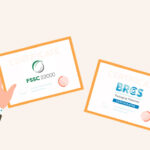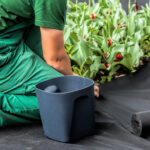BPA, or bisphenol A, is a chemical found in some plastics and resins. It can seep into food, drinks, or even products we touch, and over time, it may cause health problems. Studies suggest that BPA can interfere with hormones, potentially leading to issues like developmental delays, heart problems, and certain cancers.
For consumers, especially in industries like healthcare, food packaging, and clothing, using BPA-free fabrics is important. Polypropylene fabrics are widely used in these sectors because they are durable, lightweight, and safe. Choosing BPA-free options means reducing the risk of exposure to harmful chemicals, ensuring safer and healthier products for everyday use.
What is Polypropylene Fabric?
Polypropylene fabric is a type of plastic fabric made from a polymer called polypropylene. It is created through a process that turns the raw material into strong, flexible fibers. This fabric is used in many products you see every day.
Common uses of polypropylene fabric include shopping bags, disposable clothing, upholstery, and geotextiles for landscaping. You will also find it in items like medical supplies and food packaging, as it can help keep things clean and safe.
One of the best things about polypropylene fabric is its durability. It can withstand wear and tear, making it last a long time. It is also lightweight, which means it is easy to carry and handle. Plus, polypropylene fabric is recyclable, so it is a more eco-friendly choice compared to some other materials. This makes it a smart option for both consumers and businesses looking to reduce their impact on the environment.
Understanding BPA and Its Presence in Plastics
BPA, or bisphenol A, is a chemical used in some plastics and resins. Manufacturers often add BPA to make plastics stronger and more durable. However, it can sometimes leach into food, drinks, or other products, which may lead to health concerns, such as hormone disruption.
While polypropylene is generally considered BPA-free, there can be exceptions. Most polypropylene fabrics do not need BPA during production, but certain manufacturing processes or coatings could introduce it. This is why it’s important to check with manufacturers or look for BPA-free labels to ensure the fabric is safe for use.
Key Steps to Identify BPA-Free Polypropylene Fabrics
- Check Manufacturer Labels
The first step is to look for BPA-free labels or certifications on the fabric. Many manufacturers include this information on product packaging to help buyers make safe choices. - Ask for Product Certifications
Certifications like OEKO-TEX or FDA approval for food safety can assure you that the fabric meets safety standards. These certifications confirm that the fabric has been tested and is free from harmful chemicals like BPA. - Verify with the Supplier
If you are unsure, always reach out to the supplier. Ask them directly if the polypropylene fabric is BPA-free. Most suppliers can provide detailed information about their products. - Understand Recycling Codes
Polypropylene usually carries the recycling code “5.” This code indicates that the material is generally BPA-free. However, it’s still a good idea to confirm this with the supplier or manufacturer just to be safe.
Why Choose BPA-Free Polypropylene?
Choosing BPA-free polypropylene fabrics offers both health and environmental benefits. BPA is known to cause health risks, such as hormone disruption. By opting for BPA-free polypropylene, you reduce the risk of exposure to these harmful chemicals. This is especially important in products that come in contact with food, skin, or sensitive environments, like healthcare.
From an environmental perspective, BPA-free polypropylene is a more sustainable option. Since polypropylene is lightweight and recyclable, it produces less waste and uses fewer resources in manufacturing. Choosing BPA-free fabrics also supports safer recycling practices, reducing pollution and protecting both people and the planet.
In short, BPA-free products provide safer, healthier options for consumers while helping to promote a greener and cleaner environment.
Selecting BPA-free polypropylene fabrics is a simple yet important choice for long-term health and environmental protection. These fabrics help reduce exposure to harmful chemicals like BPA, making them safer for everyday use, especially in industries like healthcare, food packaging, and clothing. Additionally, they are more eco-friendly, as polypropylene is recyclable and contributes to reducing waste.
When purchasing polypropylene fabrics, always be proactive. Check for BPA-free labels, ask suppliers about their products, and look for certifications that ensure safety. By staying informed, you can make better choices that benefit both your well-being and the planet, ensuring you get high-quality, safe, and sustainable fabrics.




